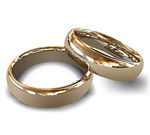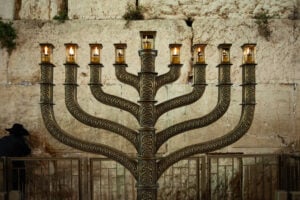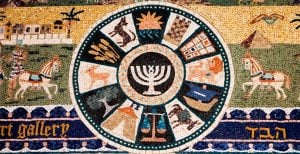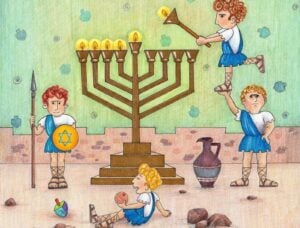 A traditional Jewish wedding is a unique and beautiful ceremony full of ancient customs and traditions, symbolizing the new spiritual and physical bond of a husband and wife. Let’s take a look at the main Jewish wedding traditions:
A traditional Jewish wedding is a unique and beautiful ceremony full of ancient customs and traditions, symbolizing the new spiritual and physical bond of a husband and wife. Let’s take a look at the main Jewish wedding traditions:
The Wedding Day
The day before the wedding should ideally be a relaxing and introspective one for the chatan (groom) and kallah (bride), where all their last minute needs are catered to by other people. In addition, this day is considered a personal Yom Kippur for both of them, for on this day all their past mistakes are forgiven as they merge into a new, complete soul. To help get into this mind frame it is customary, as on Yom Kippur, for both the chatan and kallah to fast on this day. This is also symbolized by the kittel the chatan wears at the ceremony, the traditional white robe also worn on Yom Kippur.
Kabbalat Panim
It is customary for the chatan and kallah not to see each other for one week up to the event itself, so prior to the wedding ceremony the chatan and kallah greet guests separately. During this “Kabbalat Panim”, the kallah is seated on her “throne” to receive her guests, surrounded by the women closest to her, while the chatan is surrounded by guests who sing and toast him.
Badeken
The first time they see each other is the badeken, the Ashkenazi custom where the chatan proceeds to where the kallah is seated and places a veil over her face. (Badeken is a Yiddish word meaning “to cover over.”) The custom of covering the bride’s face with a veil has its origin in the Bible when Rebecca veils herself as she is told that Isaac is approaching. “And she said to the servant, ‘What man is this that walketh in the field to meet us?’ And the servant said, ‘It is my master.’ And she took her veil and covered herself” (Gen. 24:64).
Chuppah
 The chatan and kallah are now escorted to the chuppah. This canopy is usually a cloth, sheet, or a tallit supported by four poles open on all sides, under which a Jewish couple stands during their wedding ceremony. Immediately upon arriving under the chuppah, the Ashkenazi custom is that the kallah circles the chatan seven times. This may derive from Jeremiah 31:22, a prophecy regarding the Messianic Era, “A woman shall surround a man.”
The chatan and kallah are now escorted to the chuppah. This canopy is usually a cloth, sheet, or a tallit supported by four poles open on all sides, under which a Jewish couple stands during their wedding ceremony. Immediately upon arriving under the chuppah, the Ashkenazi custom is that the kallah circles the chatan seven times. This may derive from Jeremiah 31:22, a prophecy regarding the Messianic Era, “A woman shall surround a man.”
Betrothal (Kiddushin)
 The groom and bride are then given to sip from a cup of wine. Wine is often associated with Kiddush, the sanctification of the day on Shabbat and festivals. Marriage, called Kiddushin, is the sanctification of a man and woman to each other.
The groom and bride are then given to sip from a cup of wine. Wine is often associated with Kiddush, the sanctification of the day on Shabbat and festivals. Marriage, called Kiddushin, is the sanctification of a man and woman to each other.
At this point the groom gives the bride her ring, traditionally a plain wedding band, and recites the declaration: Behold, you are consecrated to me with this ring according to the Law of Moses and Israel. The bride and groom are now officially husband and wife.
Ketubah (Marriage Contract)
A ketubah is a special type of Jewish prenuptial agreement. The content of the ketubah is a contract that formalizes the various requirements by Jewish law of a Jewish husband to his wife, including clothing, food and conjugal relations, and also the pre-specified amount of cash we will pay in the case of a divorce.
The Seven Blessings
The Seven Blessings are now recited over the second cup of wine. The sheva berachot contain several themes, ranging from the creation of the world to Adam and Eve in the Garden of Eden to the bride and groom. They end with a description of the joy of bride and groom that will be heard in the streets of Jerusalem at the time of messianic redemption.
Breaking the Glass
 The last part of a Jewish wedding ceremony is the traditional breaking of the glass. A glass is placed on the floor, and the chatan shatters it with his foot. It is a symbolic recognition of the yet unfulfilled spiritual and national destiny of the Jewish people.
The last part of a Jewish wedding ceremony is the traditional breaking of the glass. A glass is placed on the floor, and the chatan shatters it with his foot. It is a symbolic recognition of the yet unfulfilled spiritual and national destiny of the Jewish people.
Celebration
At this point the ceremony is over. The chatan and kallah walk from the chuppa surrounded by the singing and dancing of family and friends. It is a mitzvah for guests to bring simcha (joy) to the chatan and the kallah into the night with music, dancing, entertainment and wedding gifts. Mazel tov!







